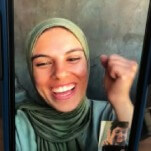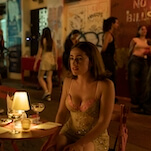Montages have fallen out of fashion in recent years. Maybe it has something to do with how mercilessly the convention was skewered by Team America: World Police, in a hilarious musical number devoted to the training montage. Maybe they’re perceived as lazy—an outmoded device best avoided. Or maybe it’s just that the default style for Hollywood filmmaking has become such a rapid-fire onslaught that montages now seem redundant. In any case, I have trouble thinking of notable recent examples. There’s a funny cross-country driving montage at the beginning of Wanderlust. Looper features an elegant sequence depicting Young Joe’s series of executions leading up to his encounter with Old Joe. A classic job-interview montage introduces The Intouchables’ no-bullshit caretaker. No doubt you’ll remind me of others I’m forgetting, especially since I don’t tend to see the Nicholas Sparks adaptations in which they might appear. As a rule, though, they aren’t nearly as prevalent as they used to be. Who will keep the tradition alive?
Wes Anderson, that’s who. Arguably, the signature moment of his career, in which an instantly identifiable “Wes Anderson movie” came into being, is the cataloguing of Max Fischer’s extracurricular activities early in Rushmore, set to The Creation’s semi-obscure “Making Time” and employing the sans-serif font (I believe it’s Futura Bold) that’s dominated his graphic design ever since. More than any other director now working, Anderson loves to condense and diversify; in every film, entire sequences are conceived and shot in meticulous snippets, almost as a reminder that the medium is (or at least was) literally a series of still photographs. His latest, Moonrise Kingdom, is particularly montage-happy, right from an opening that sees narrator Bob Balaban relay the narrative outline from all over the fictional New England island on which it’s set. But it’s the epistolary courtship between teen sweethearts Sam (Jared Gilman) and Suzy (Kara Hayward) that demonstrates Anderson’s uniquely creative way with high-speed compression.
It’s important to note that this montage is also a flashback. The designated meeting to which Sam and Suzy’s series of letters builds, in the meadow at the end of the dirt path that doesn’t have any name on it, occurs some 10 minutes earlier in the movie; we’ve already spent some time with the pair, gotten to know them. So the purpose of the sequence isn’t to dole out necessary information. And while it’s kicked off by Suzy’s parents discovering Sam’s letters, we aren’t experiencing the correspondence through their eyes—unless Sam sent all Suzy’s letters back to her for some reason, they only have half of it. (Nor do we return to the group of them standing outside the house in the dark afterward. The next scene takes place in the meadow the following day.) The montage itself is essentially independent, a discrete unit. It has no explicit function, but exists entirely for its own sake. It’s a record, a testament. An abridged love story. And a nostalgic paean to the days, now long gone, when writing actual letters back and forth was often the only means of continuing a long-distance relationship. (I’m old enough to have lived that.)
At the same time, though—and this is entirely typical of Anderson—the emphasis is less on the text of the letters than on the precise imagery accompanying that text. The first shot has Sam, who’s right-handed, seated at the extreme right of the frame, in what looks like a garage, with a bunch of older kids in T-shirts and jeans working on a car behind him. In a few quick seconds, we get a clear sense of his isolation. Then the next shot has Suzy, who’s left-handed, seated at the extreme left of the frame, in her house, with her three little brothers playing some sort of musical composition behind her. The mirror image immediately connects the lovebirds, creating a sense of “you and me against the world” in less than 12 seconds. A litany of misadventures follows, with both children’s interactions with the rest of their world gradually becoming more violent—there’s a pair of inadvertent attacks (the fire set while sleepwalking, the rock through the window), then a pair of bona fide skirmishes in which Sam and Suzy are the aggressors. Rhyming shots of them reading each other’s letters in bed give way to rhyming extreme close-ups of their words scrawled on their personalized stationery. The entire sequence is masterfully composed.
To his credit, though, Anderson seems to recognize that there’s a danger of becoming overly fussy. (Different people tend to have different ideas about when and where he’s crossed that line.) Not every shot has a direct complement, which makes the shots that are paired more effective. Sam’s drawings, for example, have no counterpart, and a shot that tracks upward to find him doing situps in his bunk is followed not by the expected downward motion, but by a proscenium view of Suzy yelling at her folks. More crucially, every letter, save for the climactic last few, is interrupted in mid-sentence. That may seem like just an affectation, and there’s a sense in which it echoes the closing advice of Team America’s song—“Always fade out in a montage / If you fade out it seems like more time has passed in a montage”—but it gives the sequence a jagged quality that it sorely needs. What’s more, it accurately reflects the way we begin to mentally draft a reply even when the other person is still speaking. Contrasted with the pained silences that tend to dominate conversation among the film’s sad adults, it’s a potent observation.
Mostly, though, montages like these give Anderson ample opportunity to indulge his fetish for detail. Note that Suzy’s binoculars are present, either around her neck or on the desk nearby, every time we see her. (There’s also a glimpse of her lefty scissors, which will shortly be used to stab a Khaki Scout.) Note that in the classroom, just before she goes berserk, you can see a sentence being diagrammed on the blackboard, and that the sentence ends with the word “storm,” prefiguring the epic storm Balaban has already told us is on its way. Note that Sam has a wedding photograph of his dead parents—poignantly stamped with PROOF—taped to his locker at the boys’ home. Note that Suzy writes in old-school cursive, which I don’t think is even taught anymore: two hooks on the capital D, an S that resembles a treble clef, etc. Most of this stuff zips by too quickly to register the first time (I didn’t see “storm” on the blackboard until just now, even though my awards screener has a fraction of the resolution available in theaters), but that doesn’t matter. It’s the overall sense of a world Anderson means to impart, as economically as possible. Far from being lazy, it’s perhaps the most labor-intensive use of the montage imaginable—not unlike that Community fake-highlights episode in which every shot is its own split-second gag in a different location. Maximal information with minimal duration. Few bother to try anymore, and nobody does it better.








































